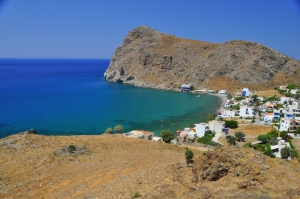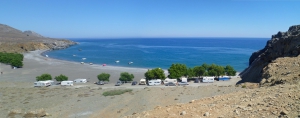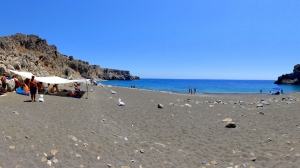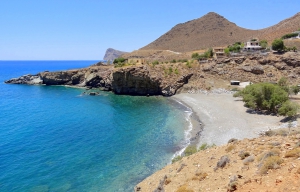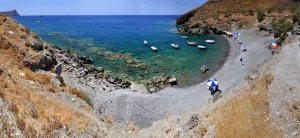Lendas is a remote coastal village located 74km south of Heraklion, on the southern slopes of the imposing Asterousia Mountains. It is a tourist resort and a port, mildly developed offering very relaxing holidays. Lendas can be accessed from Agii Deka, close to Mires town, via the village of Miamou, through a narrow paved road.
Tripiti (or Trypiti) is located 73km south of Heraklion and 12km east of Lendas, in a small plain at the exit of the gorge of Tripiti (not the homonym gorge of Sfakia area). The name is taken after the church of Panagia Tripiti, which is built inside a cave at the base of the canyon.
Trafoulas or Dragon Bay is located 4km east of Lendas and 69km south of Heraklion. It is a completely isolated beach of south Crete, which is formed at the exit of a small canyon on the Cape Trafoulas or Trahilas. According to the legend, this beach was visited by King Minos and his men, while the neighbouring Loutra beach was the bathing beach of Minos's wife, Pasiphae, and her female followers.
The gorge of Trypiti is formed at the range Asterousia, to the south of the village Vassiliki. The length of the canyon reaches 4 km and a beautiful pebble beach is formed at its exit. The beach is reached though a dirt road that runs high along the eastern side of the canyon for several kilometers before reaching its riverbed, just before the exit to the sea.
It is located at the exit of a small valley, a rare phenomenon in the wild Asterousia Mountains, which starts from the village Antiskari and ends in settlement. The fertile valley is used for growing early vegetables such as tomatoes, cucumbers, peppers, etc., since the temperature here is always high. Characteristic of the warm climate is that the swallows do not leave the area in winter.
Loutra (i.e. Baths) is located 3km east of the seaside village Lendas, 77km south of Heraklion. It is known to locals because it hosts the port of Lendas, which is protected by the Cape Trafoulas on the east.
West of Lendas you'll meet the small village of Tsigounas with the small beach of Limanaki (harbor) used as a local harbour, due to its protected orientation. Tsigounas name derives from the word tsigounis (stingy) referring to a local spring with a small quantity of water.
This is a short canyon, easily accessed that leads to the beach of Psili Ammos. The gorge has water till early spring, while it is actually a part of a longer gorge.
- 1
- 2












